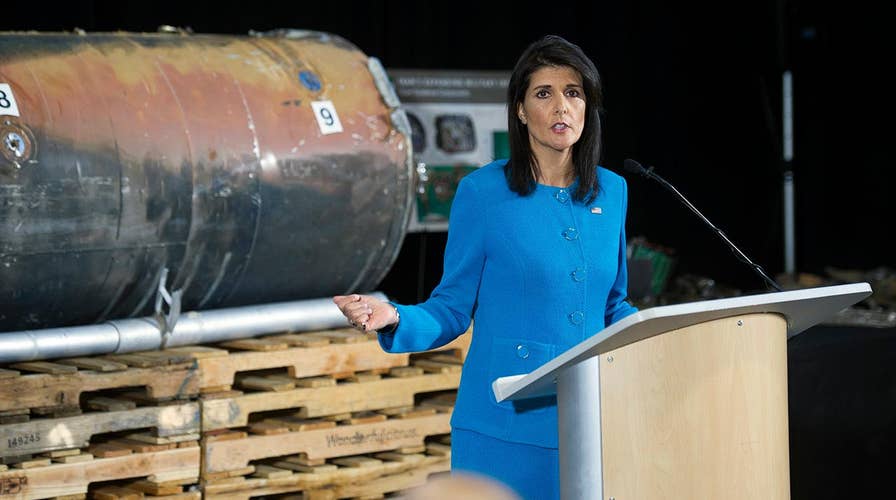Amb. Nikki Haley accuses Iran of violating nuclear agreement
International security expert Jim Walsh weighs in.
The debate about whether Iran is providing ballistic missiles to Houthi rebels in Yemen has been ended, thanks to U.S. Ambassador to the United Nations Nikki Haley, who has unveiled components of Iranian missiles recovered from target sites in Saudi Arabia fired on by the Houthis.
The U.S. has now made clear that Iran is not just violating a U.N. Security Council Resolution that imposes an arms embargo on Yemen. Iran is also violating another resolution by the U.N. Security Council that codifies the 2015 Iran nuclear deal known as the Joint Comprehensive Plan of Action.
Typically, Iran has backed the Houthis with rifles, rocket-propelled grenades, and anti-tank weapons like the Toophan, which is an Iranian copy of the American TOW missile. This transfer of basic infantry weapons has been confirmed by numerous intercepted arms transfers between Iran and the Yemeni insurgents.
However, Iran’s provision of ballistic missiles to the Houthi insurgents means that Tehran may be willing to escalate a conflict once assumed peripheral to its regional designs.
Speaking Thursday in front of the remains of an Iranian Qiam-1 missile on display at Joint Base Anacostia-Bolling in Washington, Haley underscored that the threat posed by Iran’s ballistic missile program is not limited to launches. Its missile proliferation is equally as serious and destabilizing.
Iran wants to tip the scales in Yemen while keeping its footprint light. The missiles Iran has given to the Houthis can hit major Saudi population centers, such as its capital Riyadh. This means that the Houthis can now intimidate and deter the Saudi-led coalition arrayed against them. That’s why the Qiam-1 missile is a potential game-changer.
The Qiam-1 is an Iranian liquid-fueled short-range ballistic missile based on a modified Scud design. First debuting in Iran in 2010, the Qiam-1 is Iran’s first finless ballistic missile.
Iranian outlets claim the Qiam-1 can carry up to a 750-kilogram warhead and travel up to 800 kilometers. This means that the Qiam-1 can be considered a “nuclear capable” missile, as it meets the Missile Technology Control Regime’s range and payload specifications.
The Houthis are already using the Qiam-1 to inflict terror on the Saudi population. On Nov. 4, the Houthis fired a missile they call the Burkan-2 towards King Khalid International Airport, a civilian airport in the Saudi capital. While initial media reports said the missile was intercepted, more recent analysis by missile experts revealed that it penetrated Saudi defenses.
Although the Houthis captured some ballistic missiles from Yemeni military stockpiles, including liquid-fueled Scuds and the solid-fueled Tochka SRBM, these missiles lack the range to reach Riyadh.
In her remarks Thursday, Haley said: “The Iranian Qiam missile is the only known short-range ballistic missile in the world that lacks such stabilizer fins and includes nine valves that you will see running along the length of the missile. Those valves are essentially Iranian missile fingerprints.”
Missile experts have since seconded Haley’s assertion about the missile’s links to Iran, noting the materials used in the airframe matched those used by the Iranians.
Until now, Washington had not offered hard evidence to support its charge that Iran was providing surface-to-surface missiles to the Houthis. But the Defense Department has now publicized photos of the valves and markings on the Qiam missile.
Earlier it was unclear how Iran snuck the Qiam into Yemen, if at all. In the fall of 2016 Reuters reported that Iran was using land routes via Oman to smuggle other weapons to the Houthis.
Previously, a U.N. report suggested it would be extremely challenging to smuggle a ballistic missile over land, yet now the Defense Department photos indicate that Iran cut the missile’s body into pieces and later welded them back together.
The more information the U.S. makes public about Iran’s provision of men, money and munitions to the Houthis and other violent non-state actors in the Middle East, the easier time it will have making the case for tougher sanctions and coercive measures against Tehran.
Washington must work to stem the flow of Iranian arms to Yemen, impose economic costs on Tehran and beef up the missile defense systems of its partners in the region. While Iran can be expected to continue denying that it is arming the Houthis, the evidence presented by Ambassador Haley speaks for itself.





















